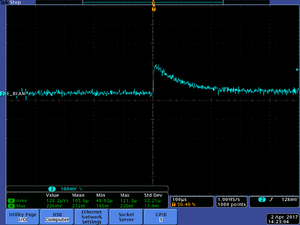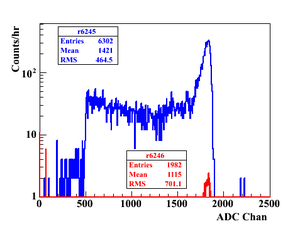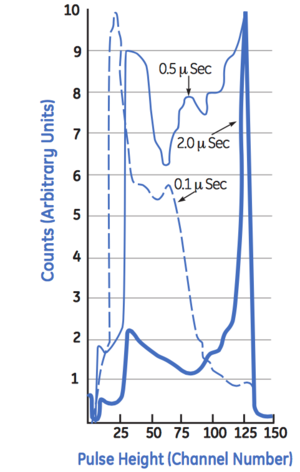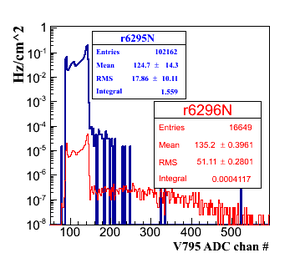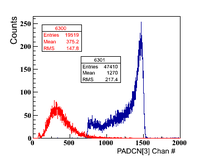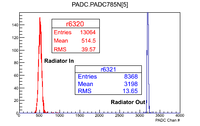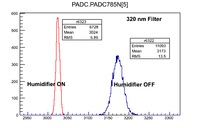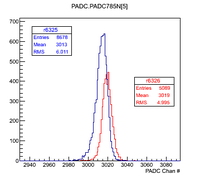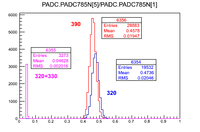He3Tube Equipment
Analog Signals
He3 Tube neutron detectors are 52 cm long and 1.5 cm radius cylinders, 1200 Volts with EG&G (ortec) pre amp Model 142PC (Serial #787)
Although 1200 Volts is applied to the Ortec Preamp, only 350 Volts is established on the "input" port where the Tube is plugged in. If 1250 Volts is applied, then 366 Volts is observed.
For the TENNELEC you need to apply 1650 Volts to get 362 applied to the Tube
The TENNELEC signal output at 1550 Volts has less noise with signal at about 30 mV compared to the output of the ortec. There is a230 mV DC offset on the output
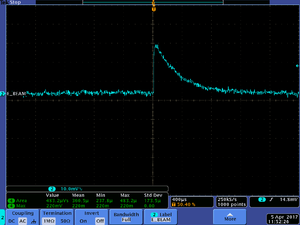
Output measured by CAEN V785N Peaks sensing ADC
Using a Cf-252 source positions on a shelf below the He-3 tube covered by 2" thick virgin Poly and set to 1250 Volts. Using Ortec pre-amp 142PC serial # 787.
The Timing output of the preamp was sent to an Ortec Timing filter amplifier to be inverted. The Gain was set to x10 and the integrate set to 20 ns.
The Energy output was sent to an Ortec Spectroscopy amplifier model 672. The gain was set to x10 and the shaping time set to 2usec.
Run 6245 has a Cf-252 source place on a shelf approximately 80 cm below the He-3 tube that had been encased in 2" thick virgin poly.
Run 6246 recorded the background observed without the source over a 19 hour period.
The expectation from File:GE ReuterStokes.pdf is
Performed another measurement of the He-3 tube using the Cf-252 source. I used the bipolar output of the ORTEC spec AMP model 672. The He-3 tube is surrounded by a 2" thick layer of virgin poly. The virgin poly is then encased in a 2" layer of lead. The Cf-252 source was placed directly on top of the lead. Below is a measurement recorded in run #6295 taken over a 7 minute period Run #6596 was taken over a three day period.
If I normalize the rate per cm^2 of detector (project the cylinder to a 52 cm x 3 cm rectangle = 156 cm^2)
Cosmic rays produce 10^{3}/cm^2/sec
PAA->Draw("PADC785N[3]>>r6296N(500,0,1000)",".00000002473");
PAA->Draw("PADC785N[3]>>r6295N(500,0,1000)",".000015263");
Beam Tests
5/16/17: 44 MeV machine was being tuned at 2 MeV so I used the nCorHe3 configuration to look at the He-3 output when there shouldn't be neutrons in the Hall.
Run 6297: Timing AMp =2 Postamp to PADC set to gain of 10
Run 6298: Timing AMp=2 Postamp to PADC set to gain of 50
Run 6299: Timing AMp=adjusting during run Postamp to PADC set to gain of 50
Run 6300: Timing AMp=8 Postamp to PADC set to gain of 50
A CFD threshold of -181 mV will keep the He-3 tube timing amp from firing when the 44 MeV machine is running. The Cf-252 source rate was 200 +/- 40 Hz at this CFD setting.
For ADC do
FF->Draw("PADC.PADC785N[3]>>(500,0,1000)");
For TDC (Window is 1500 nsec wide)
FF->Draw("(TDC.TDC1190[1][28]-TDC.TDC1190[1][31])*0.1")
Check Timing with FF->Draw("(TDC.TDC1190[2][31]-TDC.TDC1190[1][31])*0.1")
The above should be about 200 ns
Run 6301, ran in PAA configuration with Cf 252 source on top of detector
PAA->Draw("PADC.PADC785N[3]>>r6301(2000,0,2000)")
5/23/17
32 MeV Beam 50 mA current
The He-3 tube is plugged into a scaler that counts all pulses (not just the ones during the beam gate).
| Run# | Configuration |
| 6310 | 710 +/- 20 Hz neutron rate during first 15 minutes, then 870 +/- 20 Hz neutron rate during second 15 minutes, UV broadband pass filter |
| 6311 | 840 +/- 20 Hz neutron rate during first 15 minutes, then Hz neutron rate during second 15 minutes, 390 nm Filter |
| 6313 | 390 nm Filter, HV = 1800 ( the HV has changed from run 6311) |
| 6314 | 320 nm Filter |
| 6315 | 320 + 330 nm Filter |
the He-3 rate definitely increases during the irradiation (probably due to Hall Activity increasing)
5/24/17
32 MeV Beam 150 mA current 100 ns wide beam no beam stop, 4 mm thick (12 g) Yttrium in.
The He-3 tube is plugged into a scaler that counts all pulses (not just the ones during the beam gate).
2.54 mm Tungsten radiator
the He-3 rate definitely increases during the irradiation (probably due to Hall Activity increasing)
5/25/17
32 MeV Beam 150 mA current 100 ns wide beam no beam stop
The He-3 tube is plugged into a scaler that counts all pulses (not just the ones during the beam gate).
PMT linearity test
| Run# | Current | PMT[5] | PMT[5] Fstop |
| 6377 | 3.8 nV*sec | ||
| 6378 | 8.5 nV*sec | 1600 | |
| 6379 | 2.2 nV*sec | 837 | current changed during run |
| 6380 | 3.5 nV*sec | 1200 | |
| 6381 | 3.5 nV*sec | Position 1=open, at position 3 |
Current calibration
Changed beam current using width of the beam
| Run# | Charge | PADC Chann# | Configuration |
| 6337 | uC | 3625 26 | current calibration, 1.47 uV*sec in 50 Ohms, 2.2 usec, x10 attenuator |
| 6338 | 0.1588 | 2098 6 | current calibration, 794 nV*sec in 50 Ohms, 1.1 usec, x10 attenuator |
| 6339 | 0.058 | 1093 4.7 | current calibration, 429 nV*sec in 50 Ohms, 550 nsec, x10 attenuator |
| 6340 | 0.0378 | 504 4 | current calibration, 189 nV*sec in 50 Ohms, 225 nsec, x10 attenuator |
| 6341 | 0.0208 | 342 3 | current calibration, 104 nV*sec in 50 Ohms, 125 nsec, x10 attenuator |
slope=8.53252e-05 +/- 6.47968e-06 y-intercept=-0.0189951 +/- 0.0141188
Micro-Coulombs (uC)
FF->Draw("PADC.PADC785N[1]*8.53252e-05>>r6338(5000,0,1)");
| Run# | Charge | PADC Chann# | Configuration |
| 6366 | uC | 1351 14 | current calibration, 330 \pm 5 uV*sec in 1 Meg Ohms, 2.2 usec, |
| 6367 | 792 9 | current calibration, 190 \pm 5 nV*sec in 1 M Ohms, 2.2usec | |
| 6368 | 496 5 | current calibration, 106 \pm 3 nV*sec in 1 M Ohms, 2.2usec | |
| 6371 | 1066 10 | current calibration, 265 \pm 4 nV*sec in 1 M Ohms, 2.2usec |
